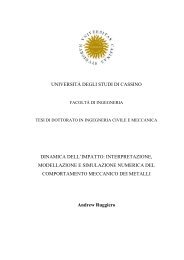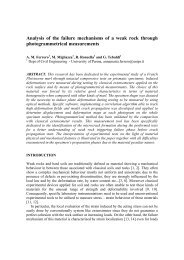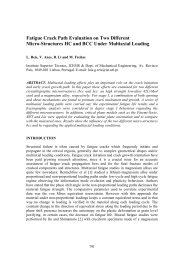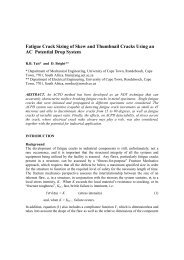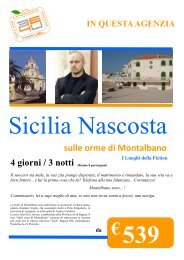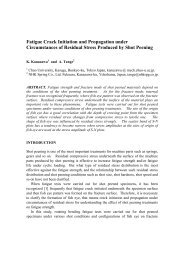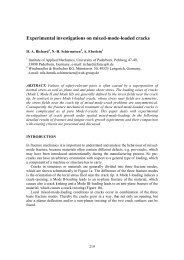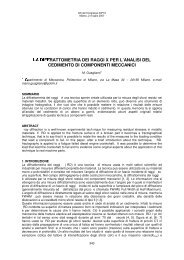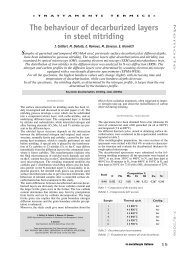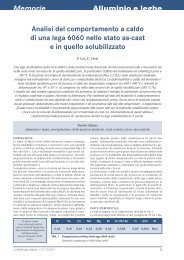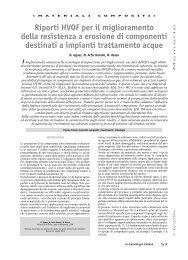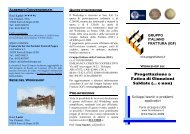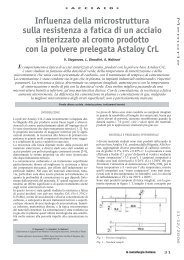a leap into the beginning of the metal - Gruppo Italiano Frattura
a leap into the beginning of the metal - Gruppo Italiano Frattura
a leap into the beginning of the metal - Gruppo Italiano Frattura
Create successful ePaper yourself
Turn your PDF publications into a flip-book with our unique Google optimized e-Paper software.
Memorie >><br />
s<br />
Fig. 12<br />
Crystallographic texture detected on a axe<br />
found in n.78 Remendello tomb [Autor: Gilberto Artioli<br />
- Università degli Studi di Padova].<br />
Tessiture cristallografiche osservate sull’ascia ritrovata<br />
nella tomba n.78 di Remedello (Autore: G. Artioli<br />
dell’Università degli Studi di Padova).<br />
realize a wider range <strong>of</strong> products to improve <strong>the</strong> quality and <strong>the</strong><br />
efficiency <strong>of</strong> <strong>the</strong> tools and <strong>of</strong> <strong>the</strong> shipping device permitting an<br />
intensification <strong>of</strong> trading across <strong>the</strong> Mediterranean Sea. Phoenicians<br />
and Greeks took important advantage from <strong>the</strong> described<br />
technological innovation.<br />
The increase <strong>of</strong> <strong>the</strong> efficiency in <strong>the</strong> steel objects realized between<br />
XI-X b.C. is proved by <strong>the</strong> rapid substitution <strong>of</strong> <strong>the</strong> bronze for <strong>the</strong><br />
realization <strong>of</strong> several objects [18].<br />
EXAMINATIONS ON DIFFERENT BLADES<br />
The blades, probably represent one <strong>of</strong> <strong>the</strong> most interesting typology<br />
<strong>of</strong> products for <strong>the</strong> evaluation <strong>of</strong> <strong>the</strong> evolution <strong>of</strong> <strong>the</strong> <strong>metal</strong>lurgical<br />
technique, because <strong>of</strong> <strong>the</strong> required combination <strong>of</strong> properties<br />
(strength-thoughness-hardness). Especially <strong>the</strong> blades <strong>of</strong> <strong>the</strong> axes<br />
and <strong>the</strong> ones <strong>of</strong> <strong>the</strong> sword are heavily loaded also in <strong>the</strong> impulsive<br />
modality.<br />
The investigation performed on <strong>the</strong> <strong>the</strong>rmo-mechanical properties<br />
performed on copper axes belonging to <strong>the</strong> Eneolitic Age can a<br />
be significant clue to understand <strong>the</strong> role played by <strong>the</strong> <strong>the</strong>rmomechanical<br />
properties on <strong>the</strong> designing <strong>of</strong> such a type <strong>of</strong> working<br />
tools. The neutronic diffraction performed by G. Artioli [19]<br />
has allowed to point out <strong>the</strong> texture developed also at <strong>the</strong> core <strong>of</strong><br />
<strong>the</strong> axes without implementing any destructive procedure. Some<br />
prehistoric axes going back between 3200b.C. and 1900b.C., have<br />
been analysed and show a crystallographic texture certainly induced<br />
through cold forming and only in some cases clear recrystallization<br />
textures have been recognized.<br />
The core <strong>of</strong> axe belonging to <strong>the</strong> Similaun man (3200b.C.) and <strong>the</strong><br />
axe <strong>of</strong> Kolmann, do not point out any particular intense texture<br />
probably for <strong>the</strong> presence <strong>of</strong> an equiaxed grain structure formed<br />
only by casting and solidification without <strong>the</strong> application <strong>of</strong> significant<br />
successive plastic deformation. Actually, <strong>the</strong> very weak<br />
texture indication seems to make reliable <strong>the</strong> hypo<strong>the</strong>sis <strong>of</strong> a static<br />
recrystallization following <strong>the</strong> application <strong>of</strong> a only slight plastic<br />
reduction (5-10%) probably aimed at restoring <strong>the</strong> shape and functionality<br />
<strong>of</strong> <strong>the</strong> tool after a certain working period.<br />
A clear presence <strong>of</strong> texture components {001} (Rotated Cube)<br />
and {001} (Cube) in <strong>the</strong> axes coming from tombs n.78 and 62<br />
at Remedello suggests that <strong>the</strong> realization <strong>of</strong> a <strong>the</strong>rmal treatment<br />
led <strong>the</strong> crystallite <strong>of</strong> <strong>the</strong> axes to orientate <strong>the</strong>mselves along <strong>the</strong> Ro-<br />
Storia della <strong>metal</strong>lurgia<br />
s<br />
Fig. 13<br />
Crystallographic texture detected on a axe<br />
found in n.62 Remendello tomb [Autor: Gilberto Artioli<br />
- Università degli Studi di Padova].<br />
Tessiture cristallografiche osservate sull’ascia ritrovata<br />
nella tomba n.62 di Remedello (Autore: G. Artioli<br />
dell’Università degli Studi di Padova).<br />
tated Cube component (Fig. 12, Fig. 13).<br />
It is extremely significant that <strong>the</strong> most sharp texture components<br />
belongs to <strong>the</strong> axes going back to <strong>the</strong> Copper Age. Actually, this<br />
texture needs <strong>the</strong> imposition <strong>of</strong> a high <strong>the</strong>rmal level applied for<br />
long time which could be reached only by <strong>the</strong> efficient refractories<br />
and combustion technique which are not typical <strong>of</strong> <strong>the</strong> first steps<br />
<strong>of</strong> Copper Age.<br />
O<strong>the</strong>r samples - nearly contemporary to <strong>the</strong> Remedello ones – usually<br />
show texture developed by textural features produced by an<br />
annealing treatment which has produced incomplete recrystallization:<br />
{211} (Copper), {321} (S), {110} (Brass),<br />
{110}(Goss) <strong>of</strong>ten organized along á-fiber, â-fiber and ã-fiber<br />
(Fig. 14, Fig. 15, Fig. 16).<br />
It is possible that <strong>the</strong> partial recrystallization was due to <strong>the</strong> attempt<br />
to modulate <strong>the</strong> mechanical properties <strong>of</strong> <strong>the</strong> axes through<br />
a compromise between <strong>the</strong> hardening featuring <strong>the</strong> plastically<br />
strained crystallite and <strong>the</strong> s<strong>of</strong>tening undergone by <strong>the</strong> recrystallized<br />
grains. The axes certainly represent a good example <strong>of</strong> <strong>the</strong><br />
<strong>the</strong>rmo-mechanical treatment applied to a mono-phase alloy in order<br />
to impose a particular combination <strong>of</strong> mechanical properties.<br />
s<br />
Fig. 14<br />
Crystallographic texture detected on Ponte<br />
Enza axe (11.6x4.9x1.1 cm3) [Autor: Gilberto Artioli -<br />
Università degli Studi di Padova].<br />
Tessiture cristallografiche osservate sull’ascia ritrovata in<br />
una tomba di Ponte Enza (11.6x4.9x1.1 cm3) (Autore:<br />
G. Artioli dell’Università degli Studi di Padova).<br />
la <strong>metal</strong>lurgia italiana >> aprile 2008 13



